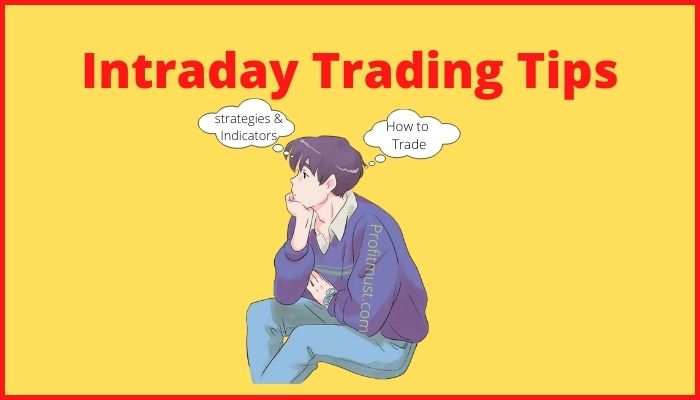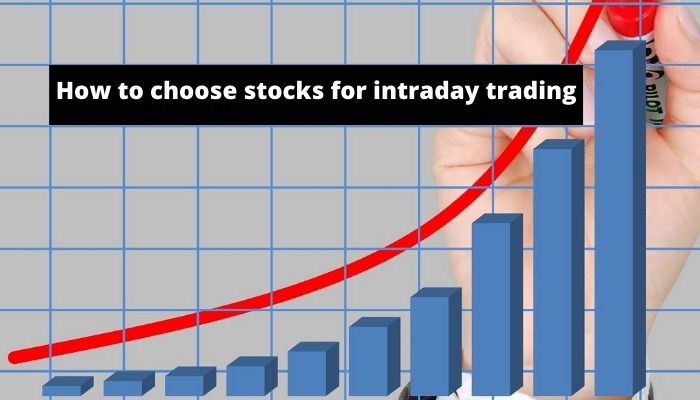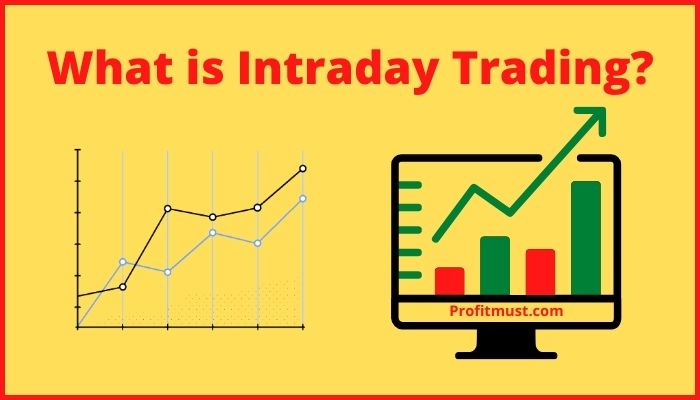When you enter the stock market, you will witness many people via YouTube videos & other social media platforms encourage you to do Intraday Trading. However, in starting the stock market, beginners don’t have an idea about Day Trading and they are completely unaware about what is Intraday Trading?
Let’s discuss what is intraday trading with examples, how does it work & Is intraday trading profitable?
Table of Contents
What is Intraday Trading?
Intraday trading meaning buying and selling stocks within a day before the stock market gets closed. Day trading is another term for intraday trading. In Intraday trading, You need to close all your open positions on a daily basis.
Intraday Trading required significant experience and knowledge of different types of indicators & Trends. Day Trading offers instant profit or loss depending on whether trades which you have initiated go right or wrong.
Let’s checkout an example to understand what is intraday trading properly.
What is Intraday Trading with Example?
Let’s take an example of HDFC Limited, you heard some good news is coming about the stock. So in the morning you bought the 30 stocks of HDFC at INR 2356 with a target of INR 2400 & stop loss of INR 2320. There can be four situations of profit and loss.
Situation 1
Things can go as per your trading experience and stocks can hit your target of INR 2400. In this case you can book a profit of INR 1320 (2400-2356=44 x 30 =1320).
Situation 2
Stock starts falling from your buying price & hits the stop loss within an hour. In this case you can book a loss of INR 1080 (2356-2320=36×30 =1080).
Situation 3
Sometimes stocks can remain range bound on either side. It means they don’t hit the target nor the stop loss. In such cases you need to close the Intraday position near to your buying price only.
Mostly this kind of trades are considered no profit no loss. However, Brokerage charges are still applicable to it.
Situation 4
The last scenario is to average a position which you have taken earlier, this kind of practice requires huge experience & not recommended to the beginners. In this case people buy or sell more quantity after making an initial position.
This can be done to reduce the losses or to get extra profit on the existing Intraday trade.

Intraday Trading Timings
You can open an intraday position in the equities that are accessible for intraday trading on both exchanges (NSE & BSE)starting at 9:15 a.m. There are only a few shares in which intraday trading is not permitted.
While most online brokerage firms require you to close your intraday position by 3:20 p.m. All trades under the equities intraday and F&O intraday will be squared off if not closed between 3:20 p.m. and 3:25 p.m.
If you don’t square off your position, brokerage services may charge a penalty of INR 30 to 50 for each order.
How does Intraday trading work?
The primary concept is to take advantage of short-term price fluctuations in the stock market. The markets are volatile on any given day, which means they vary in both directions.
Intraday trading is based on benefiting on little price swings and attempting to generate small profits on both the buy and sell sides.
While there are no hard and fast guidelines, the basic rule is to stay in stocks with a lot of liquidity and that fluctuate a lot in reaction to triggers.
You aim to purchase low and sell high in intraday trading, or sell high and then buy low again. The fundamental rule of trading hasn’t changed.
Major Advantage
When placing an intraday transaction, you must first specify that it is a MIS trade, which means it is intended for same-day square-up. If you choose CNC trade, you will be required to pay the whole purchase price upfront.
If you place an intraday trade using a MIS order, you will benefit from lower brokerage and bigger margin. In intraday trading, for example, you can receive 2 times leverage.
That means that you can trade up to Rs.2 lakh in shares with a Rs.1 lakh Fund.
How to Select Stocks for Intraday?
When it comes to Intraday Trading, picking stocks is the first and most important stage. After all, the effort and money you put in are only worthwhile if you get a return; else, it’s all over.
So, how do people make sensible stock selections? Let’s take a closer look.

-
Stay Away From Volatile Shares
It is always better to steer away from anything that appears to be unstable. Why put your money into something that may never give it back to you?
As a result, it’s a good idea to keep an eye on stock performance and consider trading over potentially steady companies.
-
Global Cues
It is preferable to invest in stocks that are linked to large industries. If the sector index rises, it may have a favourable impact on the stock price.
The iron industries, for instance, would be impacted by the appreciation of the Indian Rupee against the Chinese Renminbi.
As a result, export revenue would rise, and stock levels would rise. Choosing stocks while having such market conditions in mind would be extremely beneficial.
-
Analysis
The initial steps of trading include looking, evaluating, and comprehending. Unless you have a lot of luck on your side when trading, nothing goes smoothly without appropriate calculation.
Because luck isn’t always on your side, it’s always a good idea to do some research before you trade.
-
Flow
Being a lone wolf is n’t always preferable to following the herd. Look for the market’s overall movement or the companies that have piqued the most traders’ interest.
When the market goes up, traders must seek for stocks that are rising, and when the market drops, traders must hunt for companies that are falling.
Things to Keep in mind about Intraday Trading Meaning
Before you start Day Trading, always keep these Important things in mind:
-
Trading Approach
Intraday trading is a method that involves buying and selling stocks on the same trading day. As a result, traders profit from price changes that occur during market hours.
If the trader expects the price to grow during the day, he or she will acquire a large number of shares and then sell at a later period. Short-selling, on the other hand, is a possibility.
Traders would short-sell to profit from a sinking market. This is when they take out a loan and sell the shares on the open market.
The traders purchase stock at a cheaper price and then return them to the lender whenever the price goes down to the appropriate level.
-
Risk

Day traders are vulnerable to significant risks because they rely on volatility to make money. This is a far bigger risk that a long term share investor takes.
As a consequence, intraday traders are typically speculators ready to incur significant risks. They generally use margin trading to perform high-value trades worth thousands and crores of rupees.
To take full advantage of big margins, use Cover Orders and Bracket Orders. Intraday traders, on the other hand, can make huge profits.
-
Technical Knowledge
While day traders are mainly interested in the stock’s price and volume fluctuations, they rarely check into the actual company’s financial soundness. They frequently use technical analysis.
This includes evaluating previous stock price and volume trends in order to estimate future prices. Technical analysis can assist in determining the best times to buy and sell stocks.
This normally necessitates a significant amount of time and work. As a consequence, day traders are typically full-time traders who meticulously monitor every share change.
-
Basics
The goal is to choose equities with a high trading volume. This indicates that they are extremely liquid. This might include penny stocks as little as Rs 10.
At a time, choose no more than two or three stocks. Keeping track of more shares would become tough. Make a decision on the price you want to buy and sell at – your entry and target prices.
Above all, make sure you have a stop-loss order in place as a safety net. This will assist you in lowering your threats. After placing your order, keep an eye on it and exit when the price reaches your target or stop-loss levels.
-
Discipline
Without discipline, a profitable approach is pointless. Because they fail to create transactions that satisfy their own parameters, many day traders lose a lot of money. “Plan the trade and trade the plan,” as experts say.
Without discipline, success is unlikely. Day traders remain dependent on price fluctuations to make money. If a share moves a lot throughout the day, it may be appealing to a day trader.
This could occur as a result of a variety of factors, such as an earnings report, investor attitude, or even broad economic or corporate news.
A day trader, irrespective of approach, is generally looking to trade a share that fluctuates (a lot).
Intraday Trading Indicators
Here are the 5 major intraday trading indicators which can really helpful in day trading:
-
RSI
A flow indicator is the Relative Strength Index (RSI). It’s a single line that ranges from 0 to 100 and indicates whether a stock is overbought or oversold in the market. The market is overpriced if the reflection is greater than 70, and underpriced if it is less than 30.
However, not all stocks will follow this pattern, therefore it’s important to think about the volatility and RSI history before acting.
The RSI is also used to gauge market movement; if the RSI is greater than 50, the market is trending upwards; if the RSI is less than 50, the market is trending downwards.
-
Momentum Oscillators
Because the stock market is so volatile, prices are always fluctuating. Even when the stock market is neither bearish or bullish, there are occasions when it experiences a short-period cycle.
Traders can spot such scenarios using a momentum oscillator. It aids in determining whether market perceptions are shifting.
The oscillator connects the closing price of a stock to a range of prices throughout time. Momentum is a good indicator since it shifts before the value of the stock.
-
Moving Averages
Among investors, moving averages are one of the most well-known intraday trading indicators. The average closing rates are plotted as a line on a share chart over a specific time period in this technique.
The longer the timeframe of the share flow, the more powerful moving averages are. Because stocks are unpredictably volatile, this indicator aids a trader in determining the share’s price movement.
Because prices do not travel in a straight line, this tool will help you comprehend the price’s fundamental movement.
Because stock prices fluctuate, the moving average indicator smooths out the fluctuations to reveal the underlying pattern of price activity.
-
Bollinger Bands
Bollinger bands, which depict market volatility, are one of the greatest indicators for intraday trading. A middle bang, which is a 20-day simple moving average, an upward bang with a +2 standard deviation, and a lower band with a -2 standard deviation are the three varieties of Bollinger bands.
The price of a stock varies between the top and bottom bands. The band widens while the market is moving and unpredictability is high, and the gap narrows when volatility is low. Bollinger bands help traders figure out what a stock’s price range is.
-
Ichimoku indicator
The Ichimoku Cloud is a collection of technical indicators that show support and resistance levels, as well as trend direction and momentum. This is accomplished by calculating numerous averages and graphing them.
These numbers are also used to create a “cloud” that attempts to predict where the price will find future support or resistance. The Ichimoku Cloud was designed by Goichi Hosoda, a Japanese journalist, and was initially issued in the late 1960s.
A classic candlestick chart offers fewer datasets. While it may appear complicated at first glance, individuals who know how to read charts will discover well-defined technical indications to make it straightforward to understand.
Difference Between Intraday & Delivery
When you acquire shares on a delivery basis, you have a lot of flexibility. You have the option of keeping it or selling it the next day. It’s entirely up to you what you want to do with it. You can sell your stocks to profit whenever you believe the market is high or the value of the stocks you own is sufficient to trade.
Intraday trading necessitates the selling or buying of stocks on the same day. If you don’t, one of two things can happen. Some brokers convert the orders into delivery trades and charge a commission. Others simply square-off your trades at market price when the market closes.
Intraday vs Delivery
| Basis | Delivery | Intraday Trading |
| Time | You can carry forward your trade and hold it. | You need to square off the trade within a day. |
| Leverage | You will not get any leverage in Delivery | You will get 2x to 5x leverage in Intraday |
| Risk | Risk of losing money is less than Day Trading. | Risk of losing money is higher than Delivery |
| Profit | Earning Profit from Delivery takes a longer time. | It can give instant profit or loss within a day. |
| Technical | You don’t need much technical knowledge for it. | Technical knowledge is a must for Intraday. |
Is intraday trading is profitable?
Intraday trading is all about making minor profits on several trades in a short period of time. This aids in the reduction of losses and the generation of daily earnings.
Waiting for the correct time to trade rather than trading through every change in the stock’s price is one technique for traders to reduce their losses.
Never expect to make a large profit from a single trade; alternatively, plan several trades and achieve incremental profits. Traders are vulnerable to overtrading, which results in losses.
When it comes to intraday trading, no one has command over the stock market’s actions, therefore if a trader waits too long and the stock’s trend reverses, the trade will be lost.
Conclusion
Day trading is a practical approach to make money, despite the fact that it has become rather controversial. While day trading is still popular among beginner traders, it should be reserved for those who have the necessary skills and resources.
This is all from our side regarding what is Intraday Trading? Let us know your views about intraday trading meaning in the comment section.
Other Interesting blogs related to what is Intraday Trading?
How to choose stocks for intraday trading?
Intraday Trading Books for Indian Market
Frequently Asked Questions About Intraday Trading Meaning
What is meant by intraday trading?
Intraday trading refers to buying and selling shares on the same day. Day trading is another name for intraday trading. Intraday traders seek to profit from price fluctuations by purchasing and selling securities on the same trading day.
Can I buy 10000 shares in intraday?
Yes, 10000 shares can be bought intraday. This trade, however, is dangerous because it might result in a large profit or loss at the conclusion of the day. If you think the stock will go up, you can purchase 10,000 in the morning and sell in the afternoon. If you think the stock will go down, you can sell in the morning and buy back in the Afternoon.
What is intraday limit?
The major limit is that you can buy or sell stock only within a day. You cannot carry overnight positions on Intraday. Another limit is that you cannot wait until the last moment you need to close all your trades at 03:20 PM.
Which is more profitable intraday or delivery?
In delivery-based trading, shares purchased can be held for a longer period of time, resulting in bigger profit returns. Intraday trading, on the other hand, allows for profit to be made with low capital accounts and margin payments. Depending on your ability, both strategies can produce a good return.
What is intraday risk?
When compared to long-term investments or even short-term trades, intraday trading carries a significant level of risk. Shares move within price ranges, with the lower end of the range referred to as a support and the upper end referred to as a resistance. A stop loss is a level at which you sell your stock to avoid losing more money.

